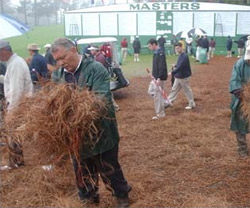![]() This is one of our off weeks from doing the Golf Talk podcast, so I wanted to take the opportunity to talk about the recent release of some golf statistics software – Scorecard – which was just bumped to version 2.0 with some well-requested features.
This is one of our off weeks from doing the Golf Talk podcast, so I wanted to take the opportunity to talk about the recent release of some golf statistics software – Scorecard – which was just bumped to version 2.0 with some well-requested features.
In the interest of disclosure, I’m a partial owner of the software company that makes Scorecard as well as one of the developers/designers for the software. It’s not free ($29.95, or $14.95 for upgrades from 1.x), and thus, I make a bit of money from the sales of Scorecard.
As I said, Scorecard 2.0 was just released with several user-requested features, including full nine-hole support for both statistics and handicap calculation, per-hole user notes (so you can document what clubs you hit or anything else you’d like), and graphing of over 35 statistics (with markers).
Continue reading “Scorecard Golf Statistics Software Now at 2.0”

 Three simple words – Stack and Tilt – have done about as much to turn the world of golf instruction upside down as anything in recent memory.
Three simple words – Stack and Tilt – have done about as much to turn the world of golf instruction upside down as anything in recent memory. A member of
A member of  Golfers who use Macintosh computers, rejoice! There’s a way to make your computer even golfier. The new Mac OS is code-named Tiger (which is pretty golfy all by itself, no?), and it has a cool feature called Dashboard. When you activate Dashboard, a serious of little web-enabled programs called Widgets pops up. There are plenty of Widgets you can install, from eBay auction trackers to local weather reports. Your golf fix is taken care of by the new Golf Tips Widget. It provides a new golf tip each day, courtesy of Golf magazine. If you’re using a Mac with Tiger installed (and if you’re not, you really should be), you can download the Golf Tips Widget
Golfers who use Macintosh computers, rejoice! There’s a way to make your computer even golfier. The new Mac OS is code-named Tiger (which is pretty golfy all by itself, no?), and it has a cool feature called Dashboard. When you activate Dashboard, a serious of little web-enabled programs called Widgets pops up. There are plenty of Widgets you can install, from eBay auction trackers to local weather reports. Your golf fix is taken care of by the new Golf Tips Widget. It provides a new golf tip each day, courtesy of Golf magazine. If you’re using a Mac with Tiger installed (and if you’re not, you really should be), you can download the Golf Tips Widget  It’s often suggested that a great drill to improve one’s putting is to roll in as many consecutive putts from several “stations” in a circle around a hole as possible. There are variations, but the theme is the same, miss one and you start over from the beginning. Not only are you improving your stroke (hopefully) but you are also simulating pressure as you get closer and closer to the end of the drill. It’s a good drill, but I’d like to suggest a slightly different one.
It’s often suggested that a great drill to improve one’s putting is to roll in as many consecutive putts from several “stations” in a circle around a hole as possible. There are variations, but the theme is the same, miss one and you start over from the beginning. Not only are you improving your stroke (hopefully) but you are also simulating pressure as you get closer and closer to the end of the drill. It’s a good drill, but I’d like to suggest a slightly different one. Having just experienced the wonder that is pine straw in North Carolina’s Pinehurst area, I come to you with a tip for hitting off of the stuff should your drives wander wayward.
Having just experienced the wonder that is pine straw in North Carolina’s Pinehurst area, I come to you with a tip for hitting off of the stuff should your drives wander wayward.